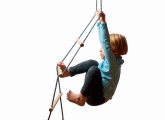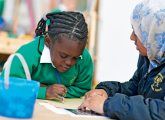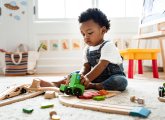For your kinaesthetic kids, there’s no time to sit still. Kirstine Beeley presents a host of creative ways to add a physical dimension to activities across the EYFS…
The importance of children’s early physical development can not be overstated. It links closely with a child’s ability to access future learning and emotional wellbeing, and has a direct impact on brain development. As one of the three prime areas within the EYFS clear emphasis is now put on this vital part of children’s education. Although the EYFS states “all areas of learning and development are important and interconnected”, I’d like to take a brief look at how you can use physical development to help build children’s knowledge and understanding in other areas – both looking at children learning to move and helping them move to learn…
The EYFS asks practitioners to help develop children’s physical wellbeing as well as their understanding of healthy living, and with this in mind, many settings revert to outdoor bike and trike play as their main method of providing for physical development. In small settings this can be an issue, as lots of whizzing round in circles is difficult when space is at a premium. But when you analyse what the EYFS actually says, that we should be “providing children with opportunities to be active and interactive”, you realise that it’s not just about providing children with a chance to ‘blow off steam’; it’s about giving children the skills to interact with different approaches to learning, and to find new ways of developing their strength and coordination, as well as getting their hearts racing. So, how and why should we make physical activity a part of learning across the board?
As we all know, children are wonderfully different – they all have their own preferred style of learning. Some learn best when they are asked to listen, whilst others prefer a more visual and vibrant way of absorbing information. There are also those who learn better when they are active. These are our kinaesthetic learners; they have an inbuilt need to move as they play, learn and grow, both indoors and outdoors. It is with these learners in mind that I’ve looked at ways of making learning and development in other areas a more physical experience, with the hope that a child who perhaps has struggled to grasp a concept presented in one way will benefit from taking another, more active approach.
Before children can pick up a pencil, pair of scissors or paint brush and control it properly they need to build on the strength in their hands, wrists and fingers, as well as developing coordination between their brain and limbs: their fine motor skills. Try writing your name holding a pencil with your toes and you will experience what it’s like when your muscles and coordination are not yet developed. Children need the chance to build these smaller physical skills in a wide variety of ways both indoors and outdoors, not just through playdough exploration.
Children also need to develop their gross motor skills: larger body movements to help build strength and coordination. As well as improving general fitness levels, the strengthening of shoulder, arm and even back muscles is crucial to early pencil control, and hence a vital precursor to early writing.
In the activities below I’ve tried to look at ways you could use both gross motor and fine motor activities to access learning across the spectrum. Many of the ideas can be easily adapted to support more or less able learners.
Admittedly there are times when children will need to run, leap, twirl and skip to burn off excess energy, and grow in confidence with their own bodies as they move. Our role as early educators is to identify when this is needed, but also to provide additional opportunities to build other skills. By providing opportunities to move with a reason we can help to build specific muscle strength, coordination and control, and in doing so we can cover learning in other areas. For example, adding stepping stones with numbers or letters on encourages children to stride and balance, whilst putting up targets with pictures of superheroes or favourite characters provides a great incentive to explore with water pistols or beanbags and balls.
There is no reason why physical development cannot be just as exciting, creative and adventurous as other areas of learning and development. So every once in a while, why not leave the bikes and trikes in the shed and try a few of these ideas?
Bucket toss
Try labelling some big buckets with numerals, and encourage children to throw balls and bean bags into the correct bucket. This is great for building arm and shoulder muscles as well as coordination. Older and more able children can throw into buckets with the answer to a simple maths problem – e.g. “one more than three”, “one less than five”, etc. Arranging the buckets in different formations helps to improve coordination and throwing skills.
Shape shooter
Cut shapes into a large, cheap tarpaulin (available from pound-type shops). Peg it up outside and encourage children to kick balls into the different shapes. Coloured tape around the holes helps to increase durability and makes the shapes more prominent, as well as adding another sorting dimension to the activity.
Step forward
Log slices with numbers on are a great way to encourage the development of balance and coordination, as well as building on counting and numeral recognition. Try mixing up the slices and asking children to move them back into order (remember, lifting and handling are part of physical development too!). Putting blackboard paint onto your log slices allows you to change numbers, or for children to add their own with chalks.
Spaghetti thread
Place strands of uncooked spaghetti in lumps of play-dough and encourage children to thread small beads onto it. As well as developing coordination and pincer movements, this provides many chances to count and make patterns according to colour or shape. Try extending the activity by adding pipe cleaners, ribbons and coloured matchsticks.
Superhero shoot
Laminate pictures of superheroes or favourite characters with numerals on them, and space them out around your outdoor area. Ask children to identify them and then squirt them with a water pistol. Squirters of different sizes will enable children to build different muscles: large squirters build muscles in arms, shoulders and backs, while small party bag-sized water pistols build strength in hands and wrists.
The joy of physical learning is that it provides opportunities on a different scale to everyday activities. This is particularly true when exploring creativity, where a chance to explore really big art can be both exciting and help to develop cooperation and the sharing of experiences and ideas.
Teabag splat
Instead of binning your teabags after making your morning cuppa, try saving them and soaking them in different coloured paints. Then let children have the chance to throw them at either a vertical (sheet on a fence) or horizontal (large piece of paper on the floor) target. This really encourages the shoulder throwing action, and gives an amazing shared final result! Why not try to splat objects with different weights to build up muscle strength and control? Try throwing balls, sponges or even cotton wool balls dipped in paint.
Yo-yo splat
Place an old sock, some sand or rice into the bottom of an old stocking or one leg of some old tights. Tie them in to give you a ball at the end of a stretchy rope. Dip the ball end into paint and bounce it up and down onto a piece of paper on the floor. Can you make a really big splat? Are there different-sized splats? What happens when the colours mix? If you want to get really physical, try moving outdoors and letting children really swing the yo-yo at the paper.
As well as planning for specific activities, some simple changes to the materials and tools you offer can expand the scope for physical development in your setting. Try extending the reach of tools such as paint brushes, chalks and pens by taping them to pieces of broom handle or bamboo canes – the extra length encourages the use and development of muscles not usually employed for brush and pencil control. Use extra-long spoons in your mixing and mud kitchen play (you can purchase wooden spoons with handles up to one metre long!).
Finally, think about the kinds or materials you offer for scooping and transporting. Using heavier materials such as gravel, cobbles and even mud makes buckets and other receptacles heavier and encourages muscle use. Why not try swapping your sandpit for a gravel pit or even having both?
One preschool I work with closely recently made the bold move of removing bikes and trikes altogether for a whole half-term, to encourage children to interact with their outdoor environment, and staff to think creatively about physical development provision. The array of creative, mathematical- and language-based activities provided was amazing, and the children really benefited from this more physical way of exploring learning – particularly the really active learners. The setting now introduces bikes and trikes occasionally to support individual children’s interests, but they are rarely out without purpose; now they are used with chalk roadways, as part of role play delivery vehicles, and even to large-scale art!
As you can see from this small snapshot there is so much more to physical development than a hop, skip and pedal approach. I really hope you get the chance to get creative with your planning and get your children active.
Kirstine Beeley is an independent trainer, author and consultant, with experience of teaching in early years, primary and SEN settings.

Boost children’s confidence by letting them try
Editors picks

Story scribing – Building writers before they can write
Editors picks

Do Infants Learn Through Play?
Editors picks
